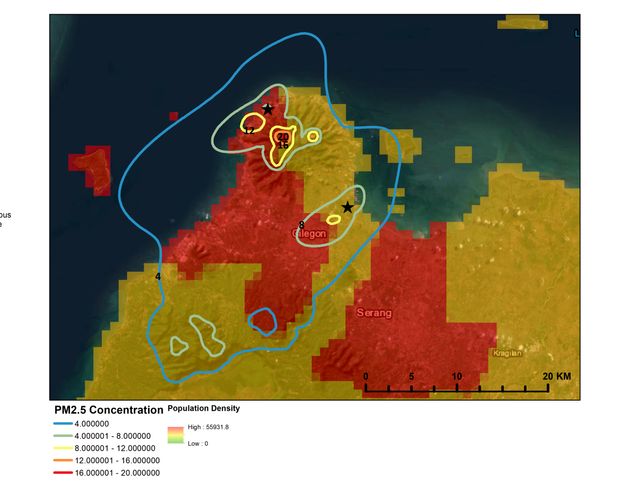Breathe Out: Modeling the Health Risks from Large-Scale Coal-Fired Power Plants in Indonesia

Access to energy is key to human development, improving health and economic outcomes as well increasing overall living standards for all individuals. However, even in countries where the majority of individuals have access to energy, there are other factors to consider, such as public health.
Energy demands continue to rise, especially in the Global South where climate change leads to increased demands for cooling, and countries are now faced with the task of how to meet growing energy needs. Meeting these demands would necessitate the construction of new energy generating facilities, with many countries continuing to build fossil-fuel powered facilities despite widespread adoption of greenhouse gas emission reduction pledges.
Many of these newly added energy generation facilities are coal-fired power plants (CFPPs) funded by Chinese investment through the Belt and Road Initiative (BRI). Even though Chinese leader Xi Jinping pledged in 2021 to stop financing new coal-fired power plant overseas and to ramp up support for renewable energy in developing countries, many plants have already been commissioned with construction underway and long lifetimes ahead of them.
Traditional fossil-fuel combustion methods for energy generation not only produce carbon-dioxide (CO2) emissions, but also emit a host of other particulates and chemical species. Fine particulate matter (PM2.5) is a major risk factor for premature deaths as increased exposure leads to stroke, heart disease, lung cancer and pulmonary disorders. Additionally, different populations such as the young and elderly are more sensitive to ambient PM2.5 exposure.
Understanding the risks to human health posed by new fossil fuel energy generation facilities is critical, as clearly stating these risks can help shift investment to alternative fuel sources or scuttle planned expansions.
In a new working paper produced by researchers at Boston University and Universitas Indonesia, we model the impact of multiple new operational CFPPs on local communities in Indonesia, quantifying the human cost of fossil fuel energy development. We find that without emission control, an excess of 1,000 premature deaths could occur annually due to PM2.5 related health conditions, at a cost of $628 million.
This study builds a 2021 journal article published in Environmental Impact Assessment Review by a team of Boston University researchers presenting an open-source approach for evaluating localized air pollution health impacts for BRI-financed CFPPs, with a focus on Pakistan.
Indonesia is one of the largest producers of coal in the world, for both domestic consumption and global export, with coal accounting for two-thirds of Indonesia’s domestic energy production. Our study focuses on the further expansion of CFFP facilities on the islands of Java and Sumatra as shown in Figure 1. Eight total facilities were modeled for this work. Information about the technical details and specifications of these facilities were taken from Environmental Impact Assessments (EIAs) or estimated from EIAs of similar facilities. Information about the local meteorology and surface features, necessary for computer modeling of pollutant plume dispersion from these CFFP stacks, were taken from freely available National Aeronautics and Space Administration (NASA) datasets.
Figure 1: Newly Commissioned CFPP Expansions in Indonesia

Data Source: Map created in Python with PyGMT.
Note: Left figure shows the extent of the study area. Right figure shows exact CFFP locations, small blue rectangles show grid boxes of atmospheric model used for meteorological inputs.
Figure 2 shows the modeled plume from two CFPP facilities (Suralaya Unit 9 and 10 PLTU Jawa-7 Cilegon) overlayed on top of a map of local population density. The plume contours (colored thick lines) represent the additional PM2.5 concentrations in micrograms per cubic meter that these facilities contribute to the atmosphere, assuming no pollution control technology is being used. In many developing countries, ensuring the usage and enforcement of these pollution control technologies, such as electrostatic precipitator (ESP), remains difficult. Due to Indonesia’s population density, many of the highest concentrations of PM2.5 (up to 20 additional micrograms per cubic meter) are directly over highly populated urban areas.
Figure 2: Modeled PM2.5 Plumes from Suralaya Unit 9 and 10 PLTU Jawa-7 Cilegon overlayed on top of local population density

Data Source: AERMOD dispersion model output (authors’ elaboration).
Note: Facility locations are marked in black stars, contours represent estimated increase in annual average annual PM 2.5 concentrations assuming no functioning ESPs.
Across the entire study area, in the absence of proper pollution controls an additional 1,061 deaths are predicted to occur annually in the study population, with an estimated staggering social cost of $628 million. Indonesia’s per-capita gross domestic product (GDP) is approximately $5,000, meaning this social cost represents the annual per-capita GDP of about 126,000 people.
These findings demonstrate that continuing to build CFFPs to meet increasing energy demands has the risk of posing detrimental social and economic harm to the surrounding immediate communities from exposure to PM2.5.
The future of Indonesia’s energy infrastructure is faced with a crossroads as it continues to weaken its pledges and goals for achieving net-zero emissions by 2060. Continuing under business-as-usual conditions and allowing for the further commission of future CFPPs may prove detrimental to the health of its people.
*
Read the Working PaperArden Radford is a PhD Candidate with the Department of Earth & Environment at Boston University and is a former Global China Pre-doctoral Fellow.
Never miss an update: Subscribe to the Global China Initiative Newsletter.